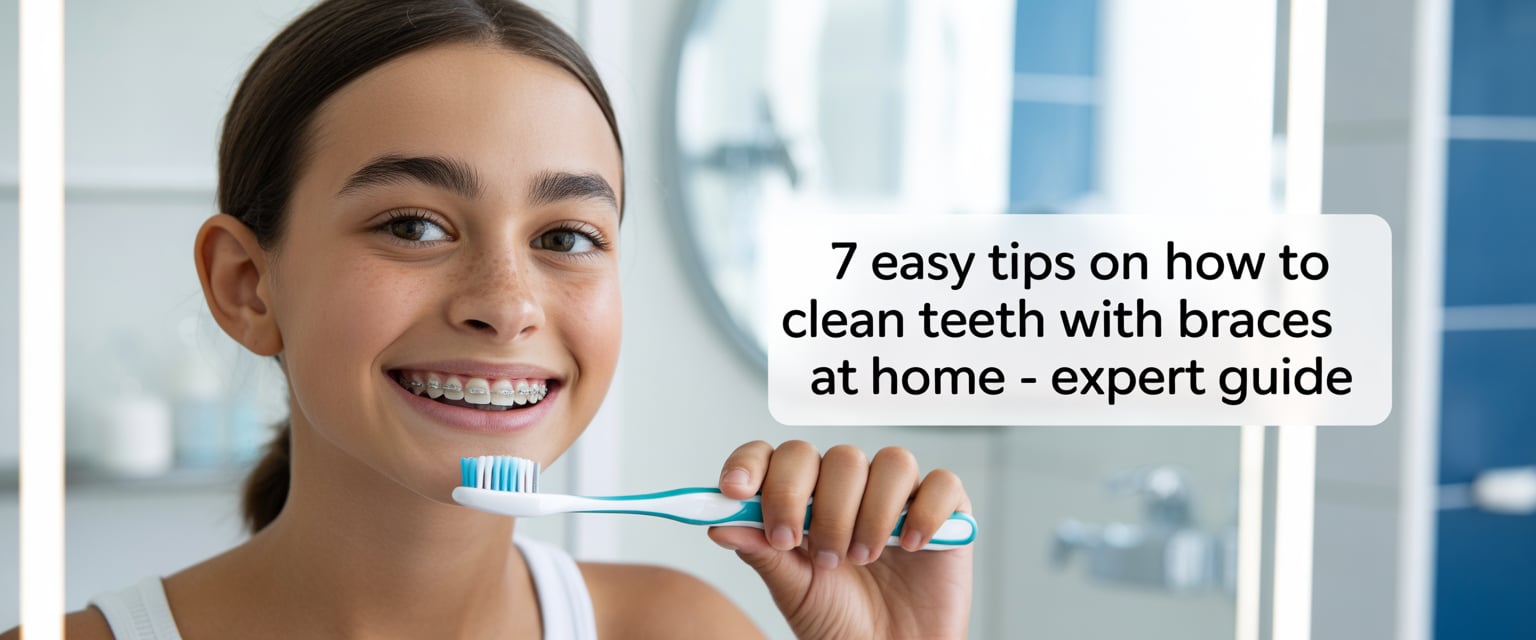Wearing braces is a big step toward achieving a perfect smile, but maintaining oral hygiene during treatment can be a real challenge. Food particles easily get trapped between wires and brackets, making regular cleaning essential to prevent plaque, bad breath, and tooth decay.
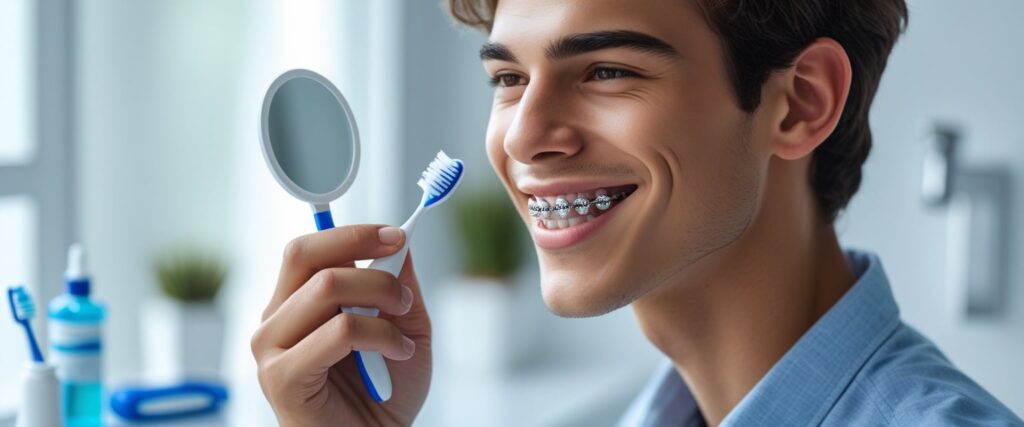
In this 7 Easy Tips on How to Clean Teeth with Braces at Home: Expert Guide, we’ll show you simple yet effective ways to keep your teeth sparkling clean and your braces in top condition. Whether you’re new to orthodontic care or looking to improve your cleaning routine, this 7 Easy Tips on How to Clean Teeth with Braces at Home: Expert Guide offers dentist-approved advice, easy-to-follow steps, and smart tools that make your daily oral care simple, safe, and successful.
Table of Contents
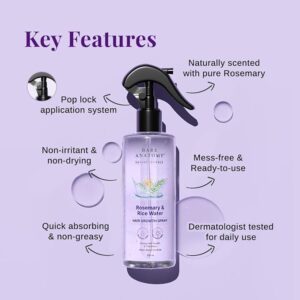
Bare Anatomy Rosemary & Rice Water Spray
He’s the kind of man who believes that first impressions start with confidence — and confidence starts with great hair.
He doesn’t chase trends; he values results. Between long work hours, workouts, and city life, his hair faces it all — but he’s got a secret weapon: Bare Anatomy Rosemary & Rice Water Spray.
One quick spray, and his hair feels refreshed, thicker, and stronger.
No greasy residue. No harsh chemicals. Just clean, natural care that fits right into his daily routine.
Whether it’s pre-shower nourishment or a leave-in boost, this lightweight spray keeps his hair looking sharp and healthy — every single day.
He’s not just maintaining his hair — he’s investing in it.
Because real men don’t just style their hair — they take care of it.
7 Easy Tips on How to Clean Teeth with Braces at Home
Keeping teeth clean with braces takes extra care, but it’s easier than it seems when the right tools and techniques are used. The key to keeping braces clean at home is brushing and flossing carefully around brackets and wires to prevent plaque and food buildup. With a few simple habits, anyone can maintain a healthy smile and avoid common orthodontic issues.
This guide explains what tools make cleaning easier, such as interdental brushes and fluoride toothpaste, and how to use them effectively. It also covers daily oral hygiene practices that protect enamel and gums while supporting the success of orthodontic treatment.
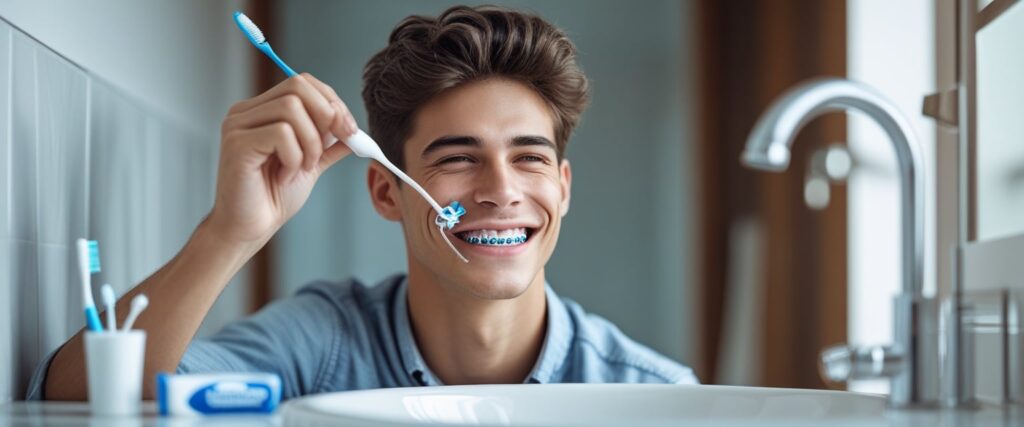
By following these easy steps, anyone with braces can keep their teeth strong, clean, and comfortable throughout treatment. The process may take a few extra minutes each day, but the results—a healthier mouth and a confident smile—make it worth the effort.
Essential Tools for Cleaning Teeth with Braces
Keeping teeth clean with braces requires tools that reach around brackets and wires while protecting enamel and gums. Using the right toothbrushes, flossing aids, interdental tools, and rinses helps prevent plaque buildup, gum irritation, and staining during orthodontic treatment.

Soft-Bristled and Orthodontic Toothbrushes
A soft-bristled toothbrush or orthodontic toothbrush helps remove plaque without damaging braces or enamel. Soft bristles clean gently around gumlines and brackets while minimizing irritation.
Orthodontic toothbrushes often have V-shaped bristles or smaller brush heads designed to reach tight areas. Many people find electric models with orthodontic brush heads effective because they maintain consistent pressure.
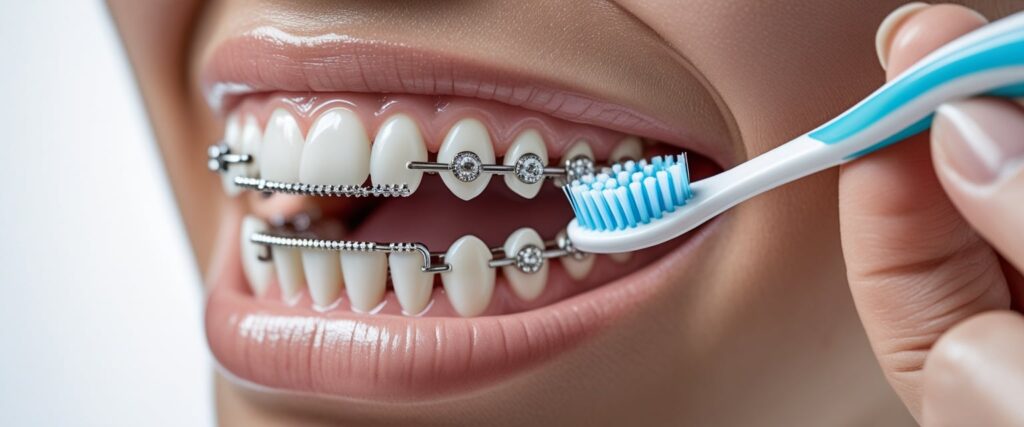
It’s best to brush after every meal using a fluoride toothpaste and replace the brush or head every three months. According to Class One Orthodontics, these toothbrushes clean effectively around wires and brackets, helping prevent cavities and gum disease.
| Type | Key Feature | Benefit |
|---|---|---|
| Soft-Bristled | Gentle on enamel and gums | Reduces irritation |
| Orthodontic | V-shaped bristles | Cleans around brackets |
| Electric | Rotating or sonic motion | Improves plaque removal |
Floss Threaders and Orthodontic Flossers
Floss threaders and orthodontic flossers make flossing possible when wires block direct access between teeth. A floss threader works like a small loop that guides regular floss under the wire, allowing cleaning between teeth.
Orthodontic flossers, such as pre-threaded or stiff-end floss, simplify the process even more. These tools remove trapped food and plaque that toothbrushes can’t reach.
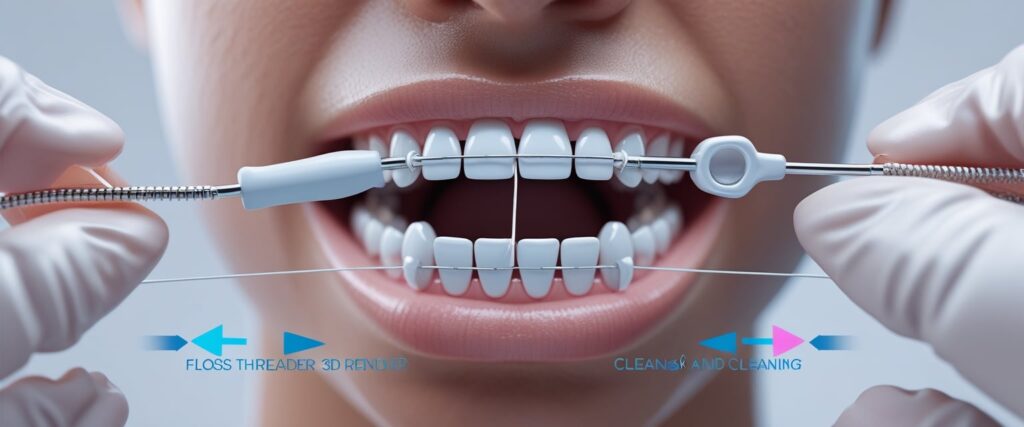
Dentists recommend flossing once a day to prevent gum inflammation. The Class One Orthodontics guide notes that floss threaders and superfloss are essential for effective cleaning around brackets and wires. Keeping a few disposable flossers on hand also helps maintain hygiene while traveling.
Interdental and Proxy Brushes
An interdental brush or proxy brush is a small, cone-shaped tool that cleans between teeth and around braces. It reaches areas that standard brushes miss, especially near brackets and under wires.
These brushes come in different sizes, so users can choose one that fits comfortably between teeth. The flexible wire and soft bristles help remove debris without scratching enamel or metal surfaces.

According to Orthodontic Braces Care, interdental brushes are a must-have for braces wearers because they clean tight areas efficiently. Rinsing the brush after each use and replacing it when worn keeps it effective and hygienic.
| Brush Size | Use |
|---|---|
| Small | For tight gaps |
| Medium | For general cleaning |
| Large | For wider spaces or molars |
Water Flosser and Mouthwash Options
A water flosser uses a pressurized stream of water to clean around braces, gums, and between teeth. It’s gentle on sensitive gums and effective at removing food particles and plaque. Regular use can reduce bleeding and improve gum health.
Pairing a water flosser with a fluoride mouthwash adds extra protection. A fluoride rinse strengthens enamel and helps prevent cavities, while alcohol-free formulas reduce dryness and irritation.
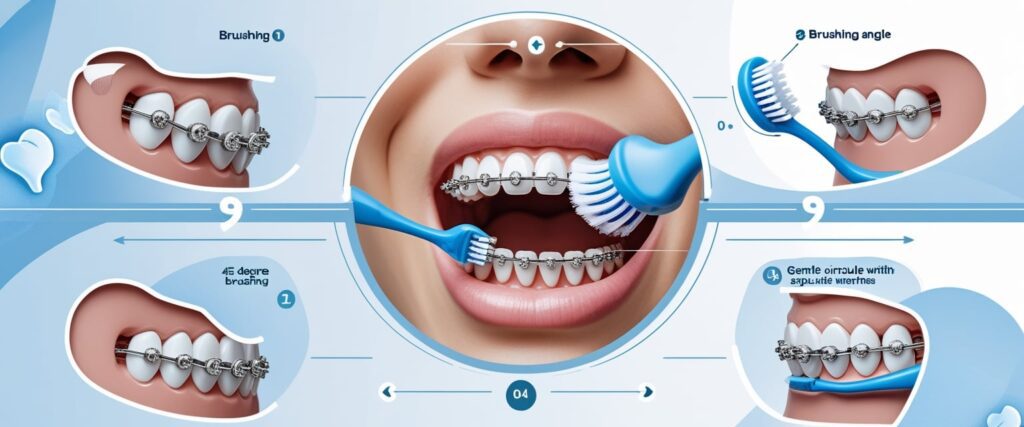
The AAO Info guide suggests keeping a portable water flosser and travel-size mouthwash for easy use away from home. Together, these tools support daily cleaning and keep breath fresh throughout orthodontic treatment.
Step-by-Step Cleaning Techniques for Braces
Good oral hygiene with braces requires careful brushing, thorough flossing, and consistent rinsing. Each step helps remove food debris and plaque that collect around brackets and wires, reducing the risk of cavities and gum problems.
Brushing with Braces: Technique and Frequency
People with braces should brush after every meal to prevent buildup around brackets and wires. Using a soft-bristled or electric toothbrush helps reach tight spaces. A small brush head allows better control and access to the gumline.
Hold the brush at a 45-degree angle to the gumline. Brush above and below each bracket using short, gentle strokes. Clean the chewing and inside surfaces of the teeth as well.
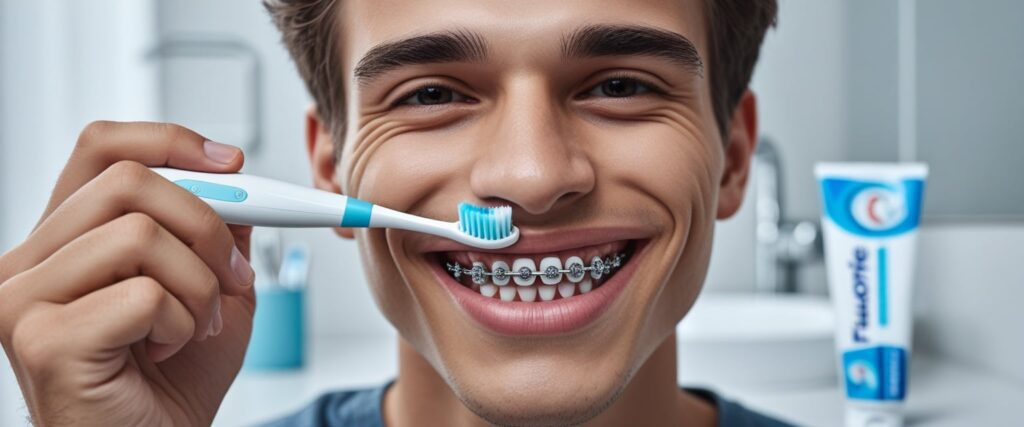
A fluoride toothpaste strengthens enamel and helps prevent decay. According to wikiHow’s guide on cleaning teeth with braces, dividing the mouth into sections—top, bottom, left, and right—ensures no area is missed. Replace the toothbrush every three to four months or sooner if bristles fray.
| Tool | Purpose | Recommendation |
|---|---|---|
| Soft toothbrush | Removes plaque around brackets | Brush 3–4 times daily |
| Interdental brush | Cleans between wires | Use after regular brushing |
| Electric toothbrush | Provides consistent motion | Use gentle pressure |
Flossing with Braces: Methods and Tools
Flossing removes plaque and trapped food that brushing alone cannot reach. Traditional floss can be used with a floss threader to guide it under the archwire. Gently move the floss up and down against each tooth, avoiding snapping or forcing it.
Some people prefer Super Floss or a water flosser, which can be easier and faster. Water flossers use a steady stream of water to flush debris and bacteria from between teeth and brackets.
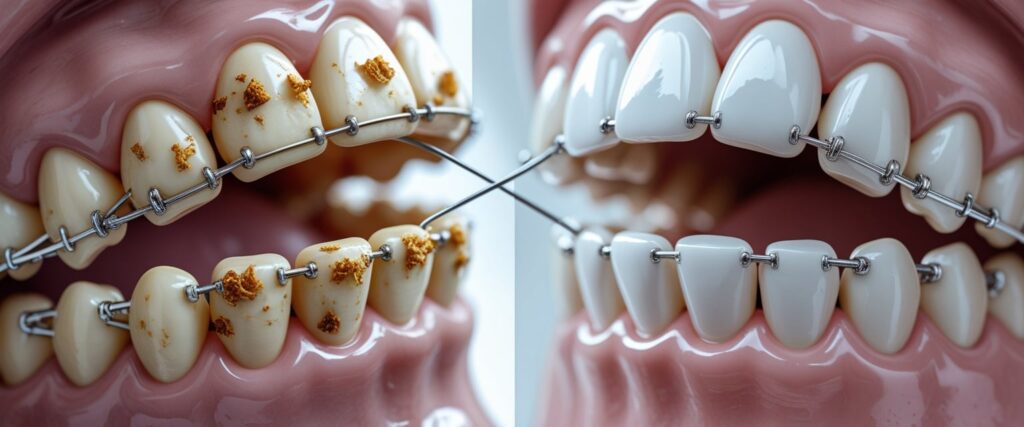
As noted in Tips Bulletin’s article on cleaning braces, flossing once a day supports gum health and prevents plaque buildup along the gumline. Consistent flossing keeps the mouth cleaner and reduces the risk of white spots after braces are removed.
Rinsing and Plaque Removal Strategies
Rinsing helps remove remaining particles and bacteria. Use an antiseptic or fluoride mouthwash to strengthen enamel and reduce plaque. Alcohol-free options prevent dryness while still disinfecting the mouth.
Swish for about 30 seconds, making sure the liquid reaches around the brackets and between teeth. After rinsing, check teeth and braces in a mirror to ensure no debris remains.
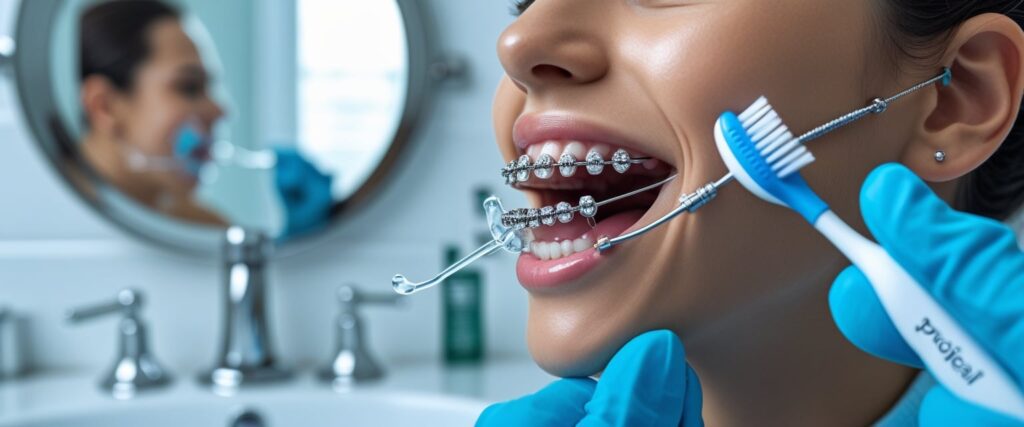
For extra cleaning, an interdental brush or proxabrush can reach areas under wires. According to Daily Tooth Care’s step-by-step guide, regular rinsing and plaque removal lower the chance of gum inflammation and tooth discoloration during orthodontic treatment.
Preventative Care and Daily Oral Hygiene Tips
Good oral hygiene with braces depends on consistent cleaning, smart food choices, and regular dental visits. Paying attention to brushing technique, diet, and gum health helps prevent plaque buildup, bad breath, and long-term dental problems.
Maintaining a Consistent Oral Hygiene Routine
People with braces should brush after every meal using a soft-bristled or electric toothbrush. Angling the brush at 45 degrees toward the gumline helps remove plaque and food particles around brackets and wires. Using fluoride toothpaste strengthens enamel and reduces the risk of cavities.
Flossing is also essential. A floss threader or water flosser can make it easier to clean between teeth and under wires. According to the CDC’s oral health tips for adults, cleaning all surfaces daily helps prevent gum disease and tooth decay.
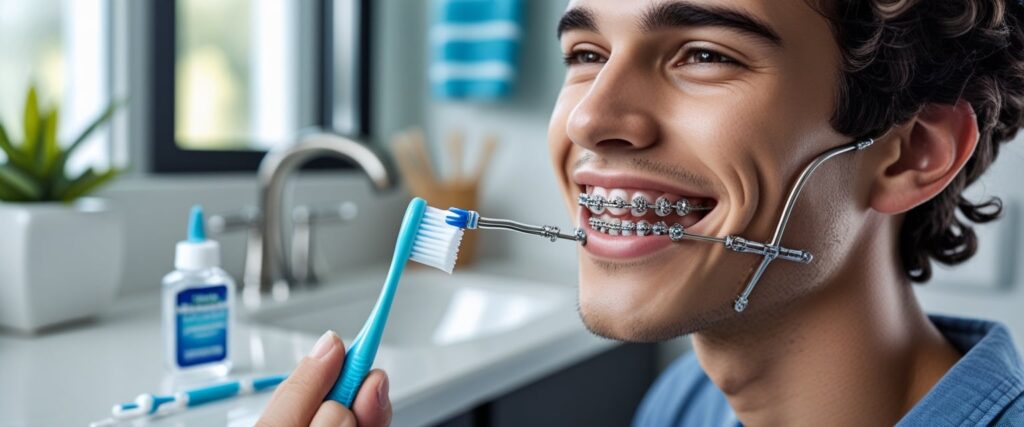
Adding a fluoride mouth rinse can further protect against plaque and bacteria. Keeping a small travel brush on hand allows quick cleaning after snacks, which supports better braces care throughout the day.
Dietary Choices and Braces Care
Diet plays a major role in dental health during orthodontic treatment. Sticky, hard, or crunchy foods can damage brackets and wires. People should avoid items like caramel, popcorn, and nuts, which can loosen braces and trap debris.
Choosing soft foods—such as yogurt, pasta, and steamed vegetables—reduces the risk of breakage. Limiting sugary and acidic drinks like soda and sports drinks helps prevent enamel erosion and cavities. The Teeth Talk Girl guide explains that cutting back on sugar and acids lowers the chance of tooth decay and staining.

For better nutrition, meals rich in vitamins A, C, and D support gum and bone health. Drinking plenty of water also helps rinse away food particles and maintain a clean mouth.
Managing Bad Breath and Gum Health
Braces can trap food, leading to bad breath and gum irritation. Cleaning the tongue daily with a tongue scraper or toothbrush helps remove bacteria that cause odor. Using an antibacterial mouthwash can reduce bacteria and freshen breath, as noted by Harvard Health.
Swollen or bleeding gums may signal early gum disease. Gentle brushing along the gumline and daily flossing help maintain healthy tissue. Staying hydrated and avoiding tobacco products also supports fresh breath and gum health.
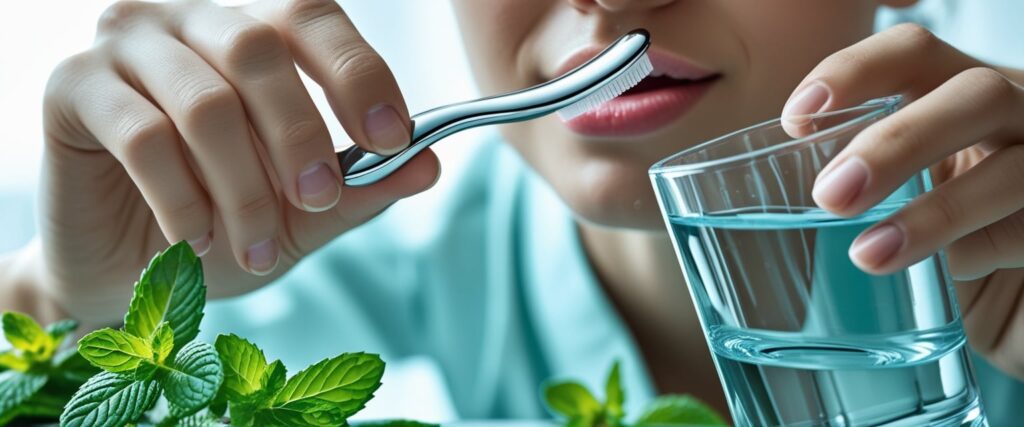
If bad breath continues, a dental professional can check for underlying issues like plaque buildup or infection.
Scheduling Regular Dental Check-Ups
Even with good home care, regular dental check-ups are vital for preventative care. Dentists and hygienists can remove hardened plaque and check for cavities or gum problems early. Visits every six months are common, though people with braces may need more frequent cleanings.
Professional cleanings help keep teeth and gums healthy while ensuring braces stay in good condition. The Metro Dental Care guide notes that routine visits allow early treatment of small issues before they become serious.

During each appointment, dental teams can adjust oral hygiene routines, recommend new tools, and ensure that braces are functioning properly.
Supporting Successful Orthodontic Treatment at Home
Good home care helps maintain clean teeth with braces and keeps orthodontic treatment on track. Paying attention to small details, staying consistent, and involving others in daily routines can make the process smoother and more effective.
Monitoring Progress and Adjusting Techniques
Regular self-checks help detect issues early. They should inspect braces for loose brackets, bent wires, or worn elastics each week. If something feels off, it’s best to contact the orthodontist rather than wait for the next visit.

Keeping a simple progress log—noting soreness, tightness, or changes in bite—can help track how the treatment is moving forward. This record supports better communication during checkups.
| Sign to Watch | Possible Action |
|---|---|
| Food trapped around brackets | Use an interdental brush or floss threader |
| Discomfort after adjustments | Rinse with warm salt water or apply orthodontic wax |
| Staining near brackets | Brush longer around the gumline and use fluoride toothpaste |
Adjusting brushing and flossing methods as teeth shift is also important. For example, using a smaller toothbrush head or switching to an electric brush can improve cleaning precision. Following these steps helps maintain oral hygiene and prevents plaque from slowing orthodontic progress, as noted in this orthodontic home care guide.
Involving Family Members in Braces Care
Family support often improves consistency. Parents or guardians can remind younger patients to brush after meals and replace worn elastics. They can also help schedule appointments and keep supplies like wax, floss threaders, and extra toothbrushes available.
Shared routines make care easier. For example, brushing together after dinner or setting phone reminders helps build lasting habits.

When family members understand the basics of orthodontics—such as avoiding sticky or hard foods—they can help prevent damage. Reviewing care tips together from trusted dental sources like Dentaly’s cleaning guide keeps everyone informed and confident in supporting successful orthodontic treatment at home.
Conclusion
Maintaining healthy, clean teeth with braces doesn’t have to be complicated—it just takes consistency, the right tools, and proper technique. By following the 7 Easy Tips on How to Clean Teeth with Braces at Home: Expert Guide, you can protect your enamel, prevent gum problems, and enjoy a fresher smile every day. Remember, orthodontic treatment is a journey, and good hygiene plays a vital role in achieving that confident, beautiful smile. Keep this 7 Easy Tips on How to Clean Teeth with Braces at Home: Expert Guide handy as your go-to reference for mastering braces care at home and ensuring your smile stays strong and bright long after the braces come off.
Frequently Asked Questions
What is the best way to clean teeth with braces?
The best way to clean teeth with braces is to brush after every meal using a soft-bristled or orthodontic toothbrush at a 45-degree angle to the gumline. Use fluoride toothpaste to protect enamel, and don’t forget to floss daily with a floss threader or water flosser to remove trapped food around brackets and wires. Interdental brushes also help reach tight spaces. Consistent cleaning keeps your teeth and braces free from plaque and stains while maintaining fresh breath and healthy gums.
What is the 3-3-3 rule for teeth?
The 3-3-3 rule for teeth means brushing your teeth for 3 minutes, at least 3 times a day, and visiting your dentist every 3 months for a professional check-up and cleaning. This simple routine helps control plaque, prevent cavities, and maintain overall oral hygiene—especially important for people with braces who are more prone to food buildup and staining.
Why do teeth turn yellow with braces?
Teeth can turn yellow with braces because food particles and plaque often get trapped around brackets and wires, making cleaning harder. If not removed properly, this buildup causes discoloration or white spots on enamel. Drinking colored beverages like tea, coffee, or soda can also stain teeth. Using fluoride toothpaste, avoiding staining foods, and maintaining good oral hygiene can prevent yellowing and keep your smile bright during treatment.
Can I just brush my teeth with braces?
Brushing alone isn’t enough when you have braces. While brushing removes surface debris, flossing and rinsing are equally important to clean between wires and around brackets where bacteria hide. You should use a combination of brushing, flossing (with threaders or a water flosser), and fluoride mouthwash for complete oral care. This routine ensures your teeth stay clean, gums stay healthy, and braces remain in good condition throughout treatment.
